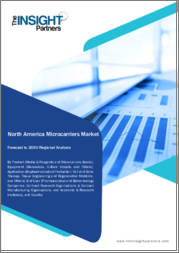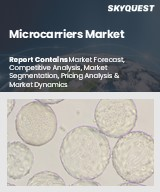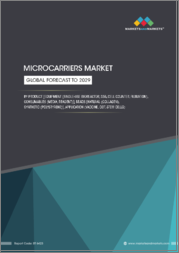
|
시장보고서
상품코드
1494453
북미의 마이크로캐리어 시장 예측(2030년) : 지역별 분석 - 제품, 장비, 용도, 최종사용자별North America Microcarriers Market Forecast to 2030 - Regional Analysis - by Product, Equipment, Application, and End User |
||||||
북미의 마이크로캐리어 시장은 2022년 7억 3,667만 달러에서 2030년에는 19억 3,356만 달러로 성장할 것으로 예상되고 있습니다. 2022-2030년의 CAGR은 12.8%를 기록할 것으로 추정되고 있습니다.
세포·유전자 치료 제조 서비스의 자동화가 북미의 마이크로캐리어 시장을 지원
세포 및 유전자 치료제 제조에 자동화를 도입하면 오염 위험을 줄이고 일관성을 높이며 제조 비용을 절감할 수 있으며, Lonza의 Cocoon과 Miltenyi의 CliniMACS Prodigy 시스템은 CAR-T 공정의 대부분의 연속적인 단위 작업를 하나의 시스템으로 자동화할 수 있도록 설계된 시중에서 판매되고 있는 장비 중 일부입니다. 세포 및 유전자 치료에 대한 수요가 증가함에 따라 전 세계에서 생산이 소량 생산에서 대량 생산으로 전환되고 있습니다. 2020년 7월, Thermo Fisher Scientific과 라이엘 임노파마는 암 환자를 위한 효과적인 세포 치료제를 설계하는 프로세스를 개발하기 위해 제휴를 맺었습니다. 프로세스를 개발하기 위해 제휴를 맺었습니다. 이 제휴에 따라 양사는 T세포의 능력을 향상시키기 위해 시약, 소모품, 장비와 함께 cGMP(current good manufacturing practice)를 준수하는 통합 플랫폼(시스템 및 소프트웨어)의 개발을 지원할 예정입니다. 또한 미국 정부 지원 기관은 국가 생산 능력을 향상시키기 위해 세포치료제 제조에 자동화를 도입하고 있습니다. 이처럼 자동화는 마이크로캐리어 시장의 새로운 트렌드로 부상하고 있습니다.
북미 마이크로캐리어 시장 개요
북미 마이크로캐리어 시장은 미국, 캐나다, 멕시코로 구분됩니다. 이 지역에서는 미국이 시장을 독점하고 있습니다. 북미 마이크로캐리어 시장의 성장은 생명 공학 및 바이오 제약 기업의 제품 출시 증가, 주요 시장 기업의 존재, 다양한 학술연구 기관의 광범위한 조사 개발에 기인합니다. 만성질환의 유병률 증가는 미국 마이크로캐리어 시장의 성장을 가속하는 주요 요인입니다. 미국 질병예방통제센터(CDC)에 따르면 미국인 10명 중 6명이 심장병, 뇌졸중, 암, 당뇨병 등 적어도 한 가지 이상의 만성질환을 앓고 있다고 합니다. 이러한 질병은 미국내 사망과 장애의 주요 원인이며, 의료 비용에 막대한 비용을 초래합니다. 세포 및 유전자 치료(CGT) 분야에서 광범위한 임상 개발이 이루어지고 있으며, 2016-2021년까지 분석 기간 중 12개의 새로운 치료법이 승인되고 2,900개 이상의 임상시험이 시작되면서 지난 5년간 CGT의 적용 범위가 확대되었습니다. CGT 혁신에 대한 대규모 투자가 이루어지고 있습니다. 유전자 편집 기술의 발전과 그에 따른 기술의 치료 효과를 평가하는 임상시험은 미국 마이크로캐리어 시장에 이익을 가져다주는 또 다른 요인입니다. 예를 들어 포세이다 테라퓨틱스(Posaida Therapeutics)는 로슈(Roche)와의 제휴를 통해 재발성 및 불응성 B세포 악성 종양 치료를 위해 CD19 항원과 CD20 항원을 모두 표적으로 하는 최초의 동종 이중 CAR-T 세포 제품 후보인 P-CD19CD20-ALLO1에 대한 미국 식품의약국(FDA)의 임상 승인 신청서를 제출했습니다. 2023년 4월 전이성 세뇨관 신세포암 환자에서 새로운 동종 CAR T세포 치료제의 임상 3상 결과가 발표되었습니다. 이처럼 임상시험에 대한 참여와 투자를 늘리면 새로운 치료법의 채택과 활용을 가속화할 수 있습니다. 텍사스대학교 MD 앤더슨 암센터(University of Texas MD Anderson Cancer Center) 연구진이 1상 임상시험을 주도하여 미국암연구협회(AACR) 연례학술대회(2023)에서 발표했으며, 2023년 8월 아스텔라스제약과 포세이다 테라퓨틱스(Posaida Therapeutics)는 포세이다의 암세포 치료 재정의에 대한 전략적 투자를 발표하였습니다. 전략적 투자를 발표했습니다. 아스텔라스제약은 여러 고형암을 적응증으로 하는 동종 CAR T세포 치료제인 P-MUC1C-ALLO1에 초점을 맞춘 포세이다의 임상 단계 프로그램 중 하나에 대한 라이선스 아웃을 위해 5,000만 달러를 투자했습니다. 이처럼 미국에서는 만성질환 환자 증가와 다양한 세포 및 유전자 치료제의 승인에 따라 마이크로캐리어에 대한 수요가 증가하고 있습니다.
북미 마이크로캐리어 시장 매출 및 2030년까지의 예측(금액)
북미 마이크로캐리어 시장 세분화
북미 마이크로캐리어 시장은 제품, 장비, 용도, 최종사용자, 국가별로 분류됩니다.
제품별로 북미 마이크로캐리어 시장은 마이크로캐리어 비드와 배지 및 시약으로 나뉘며, 2022년 북미 마이크로캐리어 시장에서 마이크로캐리어 비드 부문이 큰 비중을 차지할 것으로 예상됩니다.
장비 측면에서 북미 마이크로캐리어 시장은 바이오리액터, 배양용기, 기타로 구분됩니다. 바이오리액터 부문은 2022년 북미 마이크로캐리어 시장에서 가장 큰 점유율을 차지했습니다.
용도별로 북미 마이크로캐리어 시장은 바이오 의약품 생산, 세포 및 유전자 치료, 조직 공학 및 재생 의학, 기타로 구분되며, 2022년 북미 마이크로캐리어 시장에서 바이오 의약품 생산 부문이 가장 큰 점유율을 차지할 것으로 예상됩니다. 또한 바이오 의약품 생산 부문은 치료용 단백질 생산과 백신 생산으로 분류됩니다.
최종사용자를 기준으로 북미 마이크로캐리어 시장은 제약 및 생명공학 기업, 위탁 연구 기관 및 수탁 제조 기관, 학술 및 연구 기관으로 구분되며, 2022년 북미 마이크로캐리어 시장에서 제약 및 생명공학 기업 부문이 가장 큰 점유율을 차지할 것으로 예상됩니다.
국가별로 보면 북미 마이크로캐리어 시장은 미국, 캐나다, 멕시코로 구분됩니다. 미국이 2022년 북미 마이크로캐리어 시장을 독점했습니다.
Teijin Ltd, Bio-Rad Laboratories Inc, Sartorius AG, Danaher Corp, Corning Inc, Eppendorf SE, Asahi Kasei Corp, Polysciences Inc는 북미의 마이크로캐리어 시장에서 사업을 운영하는 대기업의 일부입니다.
목차
제1장 서론
제2장 주요 요약
제3장 조사 방법
- 대상 범위
- 2차 조사
- 1차 조사
제4장 북미의 마이크로캐리어 시장 - 주요 산업 역학
- 주요 시장 촉진요인
- 암과 감염증의 증가에 수반하는 세포치료에 대한 요구
- 세포·유전자 치료 제조의 아웃소싱의 인기 증대
- 재생의료 도입의 급증
- 시장 억제요인
- 생물제제와 세포 기반 치료제의 고비용
- 시장 기회
- 마이크로캐리어 제조업체에 의한 전략적 구상과 혁신적 제품
- 향후 동향
- 세포·유전자 치료 제조 서비스의 자동화
- 영향 분석
제5장 마이크로캐리어 시장 : 북미 시장 분석
- 마이크로캐리어 시장 매출, 2022-2030년
제6장 북미의 마이크로캐리어 시장 - 2030년까지의 매출과 예측 - 제품별
- 마이크로캐리어 비즈
- 배지 및 시약
제7장 북미의 마이크로캐리어 시장 - 2030년까지의 매출과 예측 - 장비별
- 바이오리액터
- 배양 용기
- 기타
제8장 북미의 마이크로캐리어 시장 : 2030년까지의 매출과 예측 - 용도별
- 바이오의약품 생산
- 세포·유전자 치료
- 조직공학과 재생의료
- 기타
제9장 북미의 마이크로캐리어 시장 : 2030년까지의 매출과 예측 - 최종사용자
- 제약기업 및 바이오테크놀러지 기업
- 임상시험수탁기관(CRO) 및 수탁제조 기관
- 학술·연구기관
제10장 북미의 마이크로캐리어 시장 : 2030년까지의 매출과 예측 - 국가별 분석
- 북미
- 미국
- 캐나다
- 멕시코
제11장 마이크로캐리어 시장 - 업계 상황
- 유기적 성장 전략
- 무기적 성장 전략
제12장 기업 개요
- Teijin Ltd
- Bio-Rad Laboratories Inc
- Sartorius AG
- Danaher Corp
- Corning Inc
- Eppendorf SE
- Asahi Kasei Corp
- Polysciences Inc
제13장 부록
KSA 24.06.24The North America microcarriers market is expected to grow from US$ 736.67 million in 2022 to US$ 1,933.56 million by 2030. It is estimated to record a CAGR of 12.8% from 2022 to 2030.
Automation of Cell and Gene Therapy Manufacturing Services Fuels North America Microcarriers Market
Incorporating automation in cell and gene therapy manufacturing would lead to a reduced risk of contamination, improved consistency, and decreased cost of production. Lonza Cocoon and the CliniMACS Prodigy system from Miltenyi are a few of the devices available in the market that have been designed to enable the automation of most sequential unit operations for a CAR-T process within a single system. The rising demand for cell and gene therapies has shifted production from a small-volume process to a large-volume process worldwide. The progress of cell and gene therapy from an academic and clinical setting to mass production and commercialization further propels the demand for automation in commercial manufacturing. In July 2020, Thermo Fisher Scientific Inc. and Lyell Immunopharma partnered to develop processes to design effective cell therapies for cancer patients. Under this partnership, the companies aim to improve the capability of T-cells and support the development of an integrated current good manufacturing practice (cGMP) compliant platform (system and software), along with reagents, consumables, and instruments. Further, the US government-aided organizations are adopting automation in the manufacturing of cell therapies to increase the national production capabilities of the country. Thus, automation is emerging as a new trend in the microcarriers market.
North America Microcarriers Market Overview
The North America microcarriers market is segmented into the US, Canada, and Mexico. The US dominates the market in this region. The growth of the microcarriers market in North America is attributed to the increasing number of product launches by biotechnology and biopharmaceutical companies, the presence of key market players, and extensive R&D by various academic and research institutes. The rising prevalence of chronic diseases is a leading factor propelling the growth of the microcarrier market in the US. According to the Centers for Disease Control and Prevention (CDC), 6 in 10 Americans live with at least 1 chronic disease, such as heart disease and stroke, cancer, or diabetes. These diseases are the significant causes of mortality and disability in the US, and they also lead to significant costs of healthcare. There have been extensive clinical developments in the field of cell and gene therapies (CGT), owing to which the application range of these therapies has expanded in the past 5 years. With the approval of 12 new therapies and the commencement of over 2,900 clinical trials during the analysis period of 2016-2021, there have been extensive investments in CGT innovations. Technological advancements in gene editing, followed by clinical trials to evaluate the therapeutic effectiveness of the technique, are the other factors that have benefitted the microcarriers market in the US. For example, Poseida Therapeutics, Inc. received the US Food and Drug Administration (FDA) approval for its Investigational New Drug (IND) application for P-CD19CD20-ALLO1-the company's first allogeneic dual CAR-T cell product candidate targeting both CD19 and CD20 antigens for the treatment of relapsed or refractory B-cell malignancies-being developed in partnership with Roche. In April 2023, Novel allogeneic CAR T-cell therapy delivered results in patients with metastatic clear cell renal cell carcinoma. Thus, increased participation and investments in clinical trials can accelerate the adoption and availability of new therapies. Researchers at the University of Texas MD Anderson Cancer Center led the Phase I trial and presented at the American Association for Cancer Research (AACR) Annual Meeting 2023. In August 2023, Astellas Pharma Inc. and Poseida Therapeutics, Inc. announced a strategic investment to support the advancement of Poseida's commitment to redefining cancer cell therapy. Astellas invested US$ 50 million to license one of Poseida's clinical-stage programs focusing on P-MUC1C-ALLO1, an allogeneic CAR T-cell therapy for multiple solid tumor indications. Thus, the demand for microcarriers is on the rise in the US with the increasing number of chronic disease cases and approval of different cell and gene therapies.
North America Microcarriers Market Revenue and Forecast to 2030 (US$ Million)
North America Microcarriers Market Segmentation
The North America microcarriers market is segmented into product, equipment, application, end user, and country.
Based on product, the North America microcarriers market is bifurcated into microcarriers beads and media & reagents. The microcarriers beads segment held a larger share of the North America microcarriers market in 2022.
In terms of equipment, the North America microcarriers market is segmented into bioreactors, culture vessels, and others. The bioreactors segment held the largest share of the North America microcarriers market in 2022.
Based on application, the North America microcarriers market is segmented into biopharmaceutical production, cell and gene therapy, tissue engineering and regenerative medicine, and other. The biopharmaceutical production segment held the largest share of the North America microcarriers market in 2022. Further, biopharmaceutical production segment is categorized into therapeutic protein production and vaccine production.
Based on end user, the North America microcarriers market is segmented into pharmaceutical & biotechnology companies, contract research organizations & contract manufacturing organizations, and academic & research institutes. The pharmaceutical & biotechnology companies segment held the largest share of the North America microcarriers market in 2022.
Based on country, the North America microcarriers market is segmented into the US, Canada, and Mexico. The US dominated the North America microcarriers market in 2022.
Teijin Ltd, Bio-Rad Laboratories Inc, Sartorius AG, Danaher Corp, Corning Inc, Eppendorf SE, Asahi Kasei Corp, and Polysciences Inc are some of the leading companies operating in the North America microcarriers market.
Table Of Contents
1. Introduction
- 1.1 The Insight Partners Research Report Guidance
- 1.2 Market Segmentation
2. Executive Summary
3. Research Methodology
- 3.1 Coverage
- 3.2 Secondary Research
- 3.3 Primary Research
4. North America Microcarriers Market - Key Industry Dynamics
- 4.1 Key Market Drivers:
- 4.1.1 Need for Cell Therapies with Rising Incidence of Cancer and Infectious Diseases
- 4.1.2 Increasing Popularity of Outsourcing Cell and Gene Therapy Manufacturing
- 4.1.3 Surge in Adoption of Regenerative Medicine
- 4.2 Market Restraints
- 4.2.1 High Cost of Biologics and Cell-based Therapies
- 4.3 Market Opportunities
- 4.3.1 Strategic Initiatives and Innovative Products by Microcarrier Manufacturers
- 4.4 Future Trends
- 4.4.1 Automation of Cell and Gene Therapy Manufacturing Services
- 4.5 Impact Analysis
5. Microcarriers Market - North America Market Analysis
- 5.1 Microcarriers Market Revenue (US$ Mn), 2022 - 2030
6. North America Microcarriers Market - Revenue and Forecast to 2030 - by Product
- 6.1 Overview
- 6.2 Microcarriers Market Revenue Share, by Product 2022 & 2030 (%)
- 6.3 Microcarrier Beads
- 6.3.1 Overview
- 6.3.2 Microcarrier Beads: Microcarriers Market - Revenue and Forecast to 2030 (US$ Million)
- 6.4 Media and Reagents
- 6.4.1 Overview
- 6.4.2 Media and Reagents: Microcarriers Market - Revenue and Forecast to 2030 (US$ Million)
7. North America Microcarriers Market - Revenue and Forecast to 2030 - by Equipment
- 7.1 Overview
- 7.2 Microcarriers Market Revenue Share, by Equipment 2022 & 2030 (%)
- 7.3 Bioreactors
- 7.3.1 Overview
- 7.3.2 Bioreactors: Microcarriers Market - Revenue and Forecast to 2030 (US$ Million)
- 7.4 Culture Vessels
- 7.4.1 Overview
- 7.4.2 Culture Vessels: Microcarriers Market - Revenue and Forecast to 2030 (US$ Million)
- 7.5 Others
- 7.5.1 Overview
- 7.5.2 Others: Microcarriers Market - Revenue and Forecast to 2030 (US$ Million)
8. North America Microcarriers Market - Revenue and Forecast to 2030 - by Application
- 8.1 Overview
- 8.2 Microcarriers Market Revenue Share, by Application 2022 & 2030 (%)
- 8.3 Biopharmaceutical Production
- 8.3.1 Overview
- 8.3.2 Biopharmaceutical Production: Microcarriers Market - Revenue and Forecast to 2030 (US$ Million)
- 8.3.3 Therapeutic Protein Production: Microcarriers Market - Revenue and Forecast to 2030 (US$ Million)
- 8.3.4 Vaccine Production: Microcarriers Market - Revenue and Forecast to 2030 (US$ Million)
- 8.4 Cell and Gene Therapy
- 8.4.1 Overview
- 8.4.2 Cell and Gene Therapy: Microcarriers Market - Revenue and Forecast to 2030 (US$ Million)
- 8.5 Tissue Engineering and Regenerative Medicine
- 8.5.1 Overview
- 8.5.2 Tissue Engineering and Regenerative Medicine: Microcarriers Market - Revenue and Forecast to 2030 (US$ Million)
- 8.6 Others
- 8.6.1 Overview
- 8.6.2 Others: Microcarriers Market - Revenue and Forecast to 2030 (US$ Million)
9. North America Microcarriers Market Revenue and Forecasts To 2030 - End User
- 9.1 Overview
- 9.2 North America Microcarriers Market Share by End User - 2022 & 2030 (%)
- 9.3 Pharmaceutical and Biotechnology Companies
- 9.3.1 Overview
- 9.3.2 Pharmaceutical and Biotechnology Companies: Microcarriers Market- Revenue and Forecast to 2030 (US$ Million)
- 9.4 Contract Research Organizations and Contract Manufacturing Organizations
- 9.4.1 Overview
- 9.4.2 Contract Research Organizations and Contract Manufacturing Organizations: Microcarriers Market- Revenue and Forecast to 2028 (US$ Million)
- 9.5 Academic and Research Institutes
- 9.5.1 Overview
- 9.5.2 Academic and Research Institutes: Microcarriers Market- Revenue and Forecast to 2028 (US$ Million)
10. North America Microcarriers Market Revenue and Forecasts to 2030 - Country Analysis
- 10.1 North America Microcarriers Market, Revenue and Forecast To 2030
- 10.1.1 Overview
- 10.1.2 North America: Microcarriers Market, by Country
- 10.1.2.1 US
- 10.1.2.1.1 Overview
- 10.1.2.1.2 US: Microcarriers Market Revenue and Forecast to 2030 (US$ Mn)
- 10.1.2.1.3 US: Microcarriers Market, by Product
- 10.1.2.1.4 US: Microcarriers Market, by Equipment
- 10.1.2.1.5 US: Microcarriers Market, by Application
- 10.1.2.1.5.1 US: Microcarriers Market, by Biopharmaceutical Production
- 10.1.2.1.6 US: Microcarriers Market, by End User
- 10.1.2.2 Canada
- 10.1.2.2.1 Overview
- 10.1.2.2.2 Canada: Microcarriers Market Revenue and Forecast to 2030 (US$ Mn)
- 10.1.2.2.3 Canada: Microcarriers Market, by Product
- 10.1.2.2.4 Canada: Microcarriers Market, by Equipment
- 10.1.2.2.5 Canada: Microcarriers Market, by Application
- 10.1.2.2.5.1 Canada: Microcarriers Market, by Biopharmaceutical Production
- 10.1.2.2.6 Canada: Microcarriers Market, by End User
- 10.1.2.3 Mexico
- 10.1.2.3.1 Overview
- 10.1.2.3.2 Mexico: Microcarriers Market Revenue and Forecast to 2030 (US$ Mn)
- 10.1.2.3.3 Mexico: Microcarriers Market, by Product
- 10.1.2.3.4 Mexico: Microcarriers Market, by Equipment
- 10.1.2.3.5 Mexico: Microcarriers Market, by Application
- 10.1.2.3.5.1 Mexico: Microcarriers Market, by Biopharmaceutical Production
- 10.1.2.3.6 Mexico: Microcarriers Market, by End User
- 10.1.2.1 US
11. Microcarriers Market-Industry Landscape
- 11.1 Overview
- 11.2 Organic Growth Strategies
- 11.2.1 Overview
- 11.3 Inorganic Growth Strategies
- 11.3.1 Overview
12. Company Profiles
- 12.1 Teijin Ltd
- 12.1.1 Key Facts
- 12.1.2 Business Description
- 12.1.3 Products and Services
- 12.1.4 Financial Overview
- 12.1.5 SWOT Analysis
- 12.1.6 Key Developments
- 12.2 Bio-Rad Laboratories Inc
- 12.2.1 Key Facts
- 12.2.2 Business Description
- 12.2.3 Products and Services
- 12.2.4 Financial Overview
- 12.2.5 SWOT Analysis
- 12.2.6 Key Developments
- 12.3 Sartorius AG
- 12.3.1 Key Facts
- 12.3.2 Business Description
- 12.3.3 Products and Services
- 12.3.4 Financial Overview
- 12.3.5 SWOT Analysis
- 12.3.6 Key Developments
- 12.4 Danaher Corp
- 12.4.1 Key Facts
- 12.4.2 Business Description
- 12.4.3 Products and Services
- 12.4.4 Financial Overview
- 12.4.5 SWOT Analysis
- 12.4.6 Key Developments
- 12.5 Corning Inc
- 12.5.1 Key Facts
- 12.5.2 Business Description
- 12.5.3 Products and Services
- 12.5.4 Financial Overview
- 12.5.5 SWOT Analysis
- 12.5.6 Key Developments
- 12.6 Eppendorf SE
- 12.6.1 Key Facts
- 12.6.2 Business Description
- 12.6.3 Products and Services
- 12.6.4 Financial Overview
- 12.6.5 SWOT Analysis
- 12.6.6 Key Developments
- 12.7 Asahi Kasei Corp
- 12.7.1 Key Facts
- 12.7.2 Business Description
- 12.7.3 Products and Services
- 12.7.4 Financial Overview
- 12.7.5 SWOT Analysis
- 12.7.6 Key Developments
- 12.8 Polysciences Inc
- 12.8.1 Key Facts
- 12.8.2 Business Description
- 12.8.3 Products and Services
- 12.8.4 Financial Overview
- 12.8.5 SWOT Analysis
- 12.8.6 Key Developments
13. Appendix
- 13.1 About the Insight Partners
- 13.2 Glossary of Terms



















